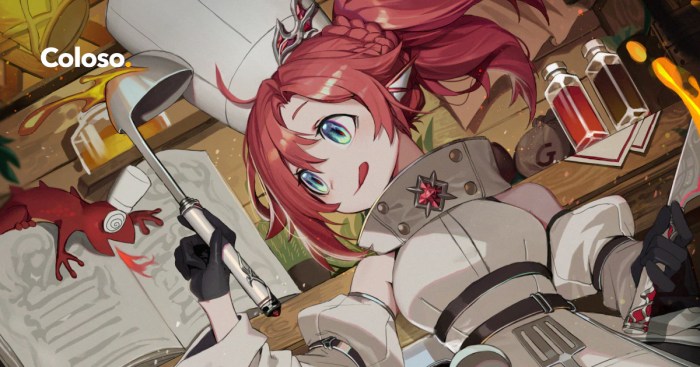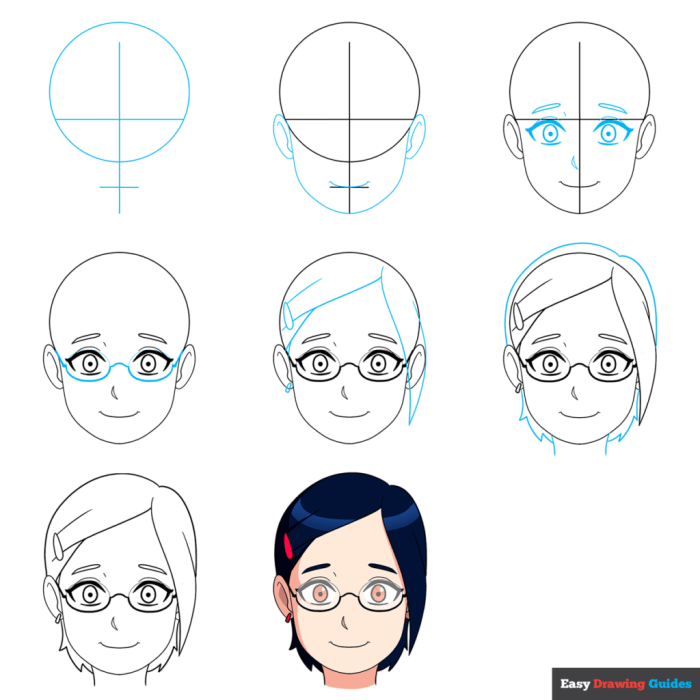Coloring Techniques for Anime Characters
Drawing & coloring anime-style characters 11 – Bringing anime characters to life involves more than just the line art; the coloring process significantly impacts the overall mood, personality, and visual appeal. This section explores various coloring mediums and techniques to achieve professional-looking results, emphasizing the importance of color theory and practical application.
Continuing our exploration of drawing and coloring anime-style characters, specifically techniques for lesson 11, consider expanding your artistic horizons. For a change of pace, you might find inspiration in the unique textures and forms of creatures found in deep sea animal coloring pages , which can help you develop your skills in shading and detail. Returning to anime characters, this broadened perspective will enrich your understanding of form and color application.
Coloring Mediums for Anime Art
Anime character coloring can be achieved using a variety of mediums, each offering unique advantages and challenges. Digital painting software provides flexibility and control, allowing for easy corrections and experimentation with color blending. Markers, particularly alcohol-based markers, deliver vibrant, saturated colors and are ideal for quick, expressive coloring. Colored pencils, on the other hand, offer a more delicate approach, allowing for fine detail and subtle shading.
The choice of medium often depends on personal preference, artistic style, and the desired level of detail.
The Role of Color Theory in Anime Character Design
Color theory plays a crucial role in shaping the visual narrative and emotional impact of an anime character. Understanding color harmonies, such as complementary (opposites on the color wheel), analogous (colors next to each other), and triadic (three evenly spaced colors), helps create visually pleasing and balanced compositions. Warm colors (reds, oranges, yellows) evoke feelings of energy, excitement, and warmth, while cool colors (blues, greens, purples) convey calmness, serenity, or even melancholy.
The strategic use of color temperature can effectively highlight character traits and emotions. For example, a character with fiery red hair might be portrayed as passionate and impulsive, while a character with cool blue hair could be perceived as calm and collected.
Color Palette for a Young Anime Character
A suitable color palette for a young anime character might include pastel shades of pink, light blue, and mint green. Pink, representing innocence and sweetness, could be used for the character’s clothing or hair accessories. Light blue, suggesting calmness and playfulness, might be used for the character’s eyes or a portion of their outfit. Mint green, conveying a sense of freshness and youthfulness, could be incorporated into the background or as an accent color.
These soft, muted colors contribute to a youthful and approachable aesthetic. The addition of a slightly darker shade of each color, such as a dusty rose, a periwinkle blue, and a sage green, allows for effective shading and depth.
Shading and Highlighting Techniques for Anime Coloring
Effective shading and highlighting are crucial for creating depth and dimension in anime coloring, making the characters appear three-dimensional and more realistic. Various techniques can be employed to achieve this effect.
- Cell Shading: This technique uses bold, flat colors with distinct Artikels, creating a graphic and stylized look often seen in anime and manga. It simplifies the shading process, focusing on strong contrasts between light and shadow.
- Soft Shading: This approach utilizes gradual transitions between light and shadow, creating a smoother, more realistic appearance. It involves blending colors seamlessly to mimic the subtle variations of light and shadow on a curved surface.
- Airbrushing: This technique, primarily used in digital art, involves using a soft brush to create smooth gradients and subtle transitions between colors, ideal for creating soft shadows and highlights.
- Hatching and Cross-Hatching: These techniques involve using parallel lines or intersecting lines to create the illusion of shading. The density of the lines determines the darkness of the shadow.
Character Design and Development: Drawing & Coloring Anime-style Characters 11

Character design and development are crucial aspects of creating compelling anime characters. A well-developed character, with a unique visual design and a believable personality, can significantly enhance the overall narrative and viewer engagement. This section explores the process of designing and developing an anime character, from initial concept to final visual representation.
Character Sketch: An 11-Year-Old Anime Fan
Let’s create a character sketch for an 11-year-old anime enthusiast named Hana. Hana is a bright and energetic girl with a passion for all things anime, particularly magical girl shows. She’s known for her infectious laughter and unwavering optimism, although she can be a bit shy around new people. Her backstory involves a recent move to a new town, leaving behind her close friends.
She uses her love of anime to cope with the transition, finding comfort in creating her own stories and characters. She dreams of becoming an animator one day.
Developing a Unique Character Design
Developing Hana’s unique design involves careful consideration of her personality and backstory. Her clothing style reflects her energetic nature and anime fandom. Imagine her wearing a brightly colored t-shirt featuring her favorite anime character, paired with comfortable jeans and sneakers. Her hairstyle could be twin pigtails adorned with small, colorful hair clips shaped like anime stars. Accessories could include a small backpack featuring anime-themed patches and a charm bracelet with pendants representing her favorite anime characters.
These elements work together to visually communicate her personality and interests.
Common Anime Character Archetypes and Their Visual Representation
Anime frequently utilizes established character archetypes. Understanding these archetypes and their common visual representations can help in designing unique yet relatable characters. For example, the “kuudere” archetype (a seemingly cold and emotionless character who secretly cares deeply) might be visually represented by a character with a stoic expression, simple clothing, and a generally reserved posture. Conversely, a “tsundere” (a character who is initially hostile or cold but gradually reveals a warmer, more caring side) might have a more vibrant outfit and expressive features, often paired with blushing cheeks or a slightly aggressive pose.
These visual cues provide instant recognition and understanding of the character’s personality.
Creating Diverse Character Designs
Creating diverse character designs is essential for representing the wide range of human experiences and appearances. Consider a character named Kenji, a 14-year-old boy of Japanese and African American descent. Kenji’s design could reflect this heritage: he might have warm brown skin, dark eyes, and hair styled in a textured afro. His clothing might be a blend of styles, perhaps a stylish graphic t-shirt paired with comfortable cargo pants and sneakers.
His facial features could be a mix of both heritages, with a strong jawline and expressive eyes. He might carry a sketchbook and pencils, reflecting his artistic interests. This detailed description allows for a unique and representative character design. Another example could be a character with a less conventional body type; perhaps a plus-size character with a confident and stylish appearance, challenging typical beauty standards.
This character could be depicted wearing clothing that flatters their body shape and reflects their personality, showcasing self-acceptance and positive body image.
Resources and Inspiration for Young Artists

Aspiring young anime artists have a wealth of resources at their fingertips, offering inspiration and guidance at every skill level. From established professionals to helpful online communities, there’s a supportive environment waiting to nurture their creativity. This section will explore some key resources to help eleven-year-olds navigate the exciting world of anime art.
Examples of Anime Artists and Their Work
Many anime artists create styles accessible and appealing to younger audiences. While it’s crucial to always prioritize age-appropriate content, focusing on artists known for their bright, expressive characters and dynamic compositions can be highly beneficial. For example, the works of artists who frequently illustrate children’s books or create character designs for family-friendly anime often feature simpler linework and bright color palettes, making them excellent examples for young artists to study.
Observing how these artists utilize positive expressions and engaging character poses can inspire budding creators to develop their own unique styles. Analyzing the use of color, line weight, and composition in their work provides valuable lessons in visual storytelling.
Online Resources and Tutorials for Anime Drawing and Coloring, Drawing & coloring anime-style characters 11
The internet offers a vast array of tutorials catering specifically to anime art. Websites like YouTube and DeviantArt host countless videos and image galleries showcasing various techniques. Many artists create beginner-friendly tutorials, breaking down complex processes into manageable steps. These resources frequently cover fundamental skills such as sketching, inking, coloring, and digital painting. Searching for terms like “anime drawing for beginners” or “easy anime coloring tutorial” will yield numerous results.
Furthermore, interactive online drawing programs often include tutorials and step-by-step guides integrated directly into the software.
Books, Websites, and YouTube Channels for Young Artists
Several resources provide structured learning paths for young anime enthusiasts. Numerous books focusing on anime drawing techniques are available for all skill levels, often incorporating exercises and projects to reinforce learning. Websites dedicated to art education often offer free lessons and resources, while YouTube channels provide visual demonstrations of various techniques. These platforms provide a mix of structured courses and informal tutorials, allowing young artists to explore different learning styles.
Categorized Resources for Anime Art
To facilitate learning, it’s helpful to organize resources by skill level and focus.
Beginner Tutorials
- Many YouTube channels offer “how-to” videos on basic anime drawing, focusing on simple shapes and linework.
- Several websites provide free printable worksheets with basic character templates and step-by-step instructions.
- Beginner-friendly books often focus on fundamental concepts like perspective, proportion, and basic anatomy.
Advanced Techniques
- Advanced tutorials delve into more complex techniques like shading, lighting, and creating dynamic poses.
- Some websites and books cover digital painting techniques using software like Photoshop or Clip Studio Paint.
- YouTube channels dedicated to advanced anime art often showcase professional artists’ workflows and techniques.
Character Design
- Resources on character design emphasize creating unique and memorable characters, focusing on aspects like personality, clothing, and backstory.
- Many books and websites provide exercises to help young artists develop their own character styles.
- Online communities and forums provide platforms for sharing character designs and receiving feedback from other artists.
